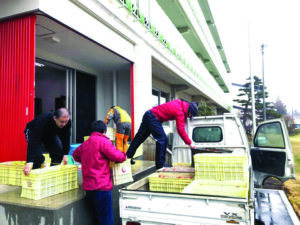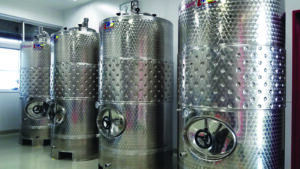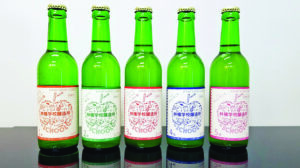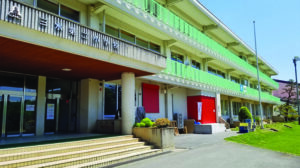The quiet town of Iizuna in northern Nagano Prefecture has an estimated population of 10,923 in 4212 households. It also once had four elementary schools, at least until the end of 2018 when the schools were forced to close due to a steadily declining number of residents (i.e. children) that began in the mid 1990s. Two new schools were opened in their stead, but what of the fate of the forsaken ones?
Incredibly, one of them was revived by unexpectedly becoming Japan’s first school-turned-cidery, the “Ringo School Cidery” (Ringo, Japanese for apple). For all intents and purposes it still looks like a Japanese-style school, save for the bright red shutter that is the entrance to the cidery.
Just how does an aged deserted school get turned into a modern day cidery? inCiderJapan interviewed Tsukasa Ono, CEO of Hokushin Gogaku Cidery (lit. Northern Nagano Five Mountain Cidery), which manages and operates Ringo School Cidery, to find out the details. Mr. Ono is also the founder and has been the director of the Japan Cider Master Association since its inception in 2015, a paid membership-based organization that collaborates with other cider-related groups and institutions, such as ourselves, to promote cider across Japan and coordinate cider-related events.
First, please tell our readers about your background.
I was born to an apple farming family in Iizuna Town. My ancestors started growing apples around the time of World War II, but we’ve always been farmers so it’s difficult to tell when we actually started farming. I’m a 4th generation apple grower and it is basically a given that it’s my duty to inherit the farm. But I left for Nagoya when I was 19 and lived there, and then in Yokohama, for over 20 years. I had a feeling that my family wanted me back, but I only vaguely started considering it in my late 20s.
Did you think it would be because of cider?
I had somewhat contemplated in the past, but it was in 2017 when I decided to shift gears and get into making cider. In order to start, I knew I would need the support and backing of Iizuna to actually build a cidery, so I ran my proposal by the town before establishing Hokushin Gogaku Cidery Co., Ltd. at the end of that same year.
How did you get involved with turning an old elementary school building into a cidery?
While I was still living in Yokohama in 2017, I went back to Iizuna to consult with the government office and was told that there was going to be a school closing in March 2018. They asked me if I could somehow make use of it.
In the beginning, the proposition of using a school building didn’t make a lot of sense, but since the underlying premise of my company was about cultivating and enriching people, the notion of using a school that had nurtured local area children corresponded with what we wanted to accomplish. The goal was not just to create cider but experiences as well, not to mention educate people about cider, so it seemed a good fit.
Furthermore, I believed running a school as the literal venue to teach at would strengthen the company’s concept and make it practical to understand while at the same time demonstrating ourselves as an active model of how to use an abandoned school to create a community-based, community-serving business.
Is there actual teaching at Ringo School Cidery?
Yes, there is! We have one-day seminars where people can come and learn about cider in the morning and then later in the afternoon get some hands-on training with cidermaking. It’s our intention and hope that people can learn more about cider and value the knowledge they receive while here. Unfortunately, we haven’t been able to hold any seminars this year due to COVID-19, but we do advertise regularly through Facebook, so please keep checking if you’re interested.
How much cider do you make, what is your production volume now?
In the fiscal year of April 2019 to March 2020, we made about 7,000 liters. Our current production license falls under the Iizuna Wine and Cider Special District exemption that allows a lower minimum volume requirement of 2,000 liters but limits ingredients to strictly Iizuna-grown fruit. We will clear the minimum provision and I think it will happen soon, but we are really now waiting to have the Special District specification* removed from our license. Once that happens, we can aim for an output of 13,000 liters, which has been our goal since the beginning.
*The license restriction was taken out shortly after this interview.
So, what is the size of the cidery then?
We have four large 1,000L tanks, one 500L, five 220L, and three smaller 100L ones. We use the 1,000L tanks mainly for our own ciders while the 500L and 200L tanks are marked for ciders we are contracted to make for local farms, but now we also have people outside of Iizuna Town asking us to make ciders for them, so we’ll start that later this year once we can start using fruit from other areas.
Speaking of your own ciders, what does your lineup look like now?
Since we’re called Ringo School Cidery, everything we do has a school-based theme. Each cider is designed and then made in the charge of one of our team “homeroom teachers” and the ciders themselves are named in the same way a Japanese elementary school designates their student groupings: “Class 1”, “Class 2”, etc. Even the labels are purposely designed to look like class notebooks. We have produced five classes and one limited edition “Memories of Summer Vacation” line so far, so in total, six.
The plan is to have around six different ciders regularly?
Yes. Six is a good number because we can easily package them as taster sets. We do, though, want to make flavored ciders in the future as well.
What are some of the pros and cons that you’ve experienced from constructing a cidery inside a school building?
We certainly encountered things we didn’t initially expect. For example, because of the raised structure (50+ cm) of the school’s foundations, we sometimes struggle when hauling things in and out. Also, since we didn’t plan and construct the cidery from scratch, we had no choice but to fit equipment into pre-existing rooms like the principal’s office or teachers’ area. That caused us to really use our heads to figure out how to lay out things.
Ah, and this was a result of our being in the mountains of northern Nagano, but the school building has heaters under the floorboards as Iizuna gets really cold in the winter. And because of the heaters, we couldn’t dig channels and grating for draining water into the floor of the cidery. We had to learn the hard way after the fact that maybe schools are not the most suitable place for a cidery, ha ha.
But there were many beneficial points that we hadn’t foreseen as well. For instance, the bitter truth is that there are many schools becoming abandoned all over Japan, so people are conscious of the reality that something needs to be done. As a result, we have many visitors who want to observe and ask questions about how we are making use of ours. Additionally, through the plenty of free media coverage that we have been graciously given, we didn’t have to invest so much money in publicity, which made it easier for us to start our business.




Speaking of visitors, how have local residents reacted to the cidery?
People have shared with us varying degrees of feedback, and we have received a lot of positive comments. Former students of the school often cheer us on. Local farmers who make cider with us appreciate that we hold seminars for them to learn about cider and how to make it, as well as actually making it together. They say they are happy that they can now make their own cider while understanding what the drink is. Likewise, Iizuna residents have told us that they’re happy they can now give our ciders as souvenirs to people outside of town. Even the local 7-11 carries our ciders and tells us that they have been selling well.
How do you think the cider industry has changed from the time you established your company in 2017 to now?
Cider is definitely better known, and I feel that more people are aware of and drinking it. Before all this, I had thought that countryside locals wouldn’t drink much cider, so my initial target market was going to be Tokyo. I have been pleasantly surprised by the numbers that show we sell more ciders locally than to places in Tokyo.
Finally, what are Ringo School Cidery’s future goals?
Our primary mission is to make cider and teach cider making, and we do it at an abandoned school turned cidery. Our secondary mission has become to make better, tastier ciders. Later in 2020, we will experiment using specialized cider yeast strains, working with the characteristics of different apples and yeasts, and adding flavors to prove that Japanese ciders are continuing to evolve and improve. Cultivating and enriching people is important but I want to do it with cider, too.
Regarding how we utilize the school, an indoor cafe is opening soon, so I want to encourage more people to visit us and enjoy the building itself. I hope that we can show the rest of Japan a good example of how to recycle a sidelined property. There are many places that are dealing with the same problem of resuscitating abandoned schools and such, so I want to show how local governments and businesses can team up to make it work.
Thank you and best success to you and Ringo School Cidery!
Thank you!
inCiderJapan will surely be monitoring Ringo School Cidery’s progress. The cafe mentioned by Mr. Ono is called Izumigaoka Kissa-Shitsu and had its grand opening in mid-July. It is run by an Iizuna native who worked in cafes outside the prefecture and returned home to take advantage of this opportunity. They serve fruit tarts topped with seasonal fruits, including Iizuna-grown apples, and espresso machine made lattes. You can of course also enjoy Ringo School’s ciders there, so why not spend your next break by venturing out and checking in on them?
Seriously, what could be more fun and original than an adult drinking cider while waxing nostalgic in the memories of their elementary school days at the same time walking the halls of one?
RINGO SCHOOL CIDERY
HOURS OF OPERATION:
Everyday except Mondays: 11:00〜16:00
Mondays: Closed
ADDRESS:
〒389-1203 Nagano, Kamiminochi District, Iizuna, Akashio 2489
TEL: 050-5876-2628
https://5gaku.com

